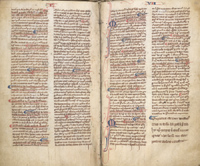 |
 |
 |
 |
 |
 |
 |
|
Fountains Abbey: History
Fountains Abbey: Buildings
|
The library (2/13) ‘He (Hugh) was the first who by a happy omen enriched the little library of Fountains.’ (34) The Fountains library was started c.1134/5 by Hugh, the former dean of York, who joined the abbey as a recruit and brought with him wealth, furniture and books. The community continued to receive gifts of books. Henry of Knaresborough donated a book in the thirteenth century and in 1516 William Peck, the master of Ripon College in Yorkshire, gave a book to Abbot Huby; this contained mostly medical treatises. The community might expand the library holdings by borrowing and copying books from other religious houses. An interesting account tells how one monk of Fountains borrowed the Life of St Godric from the community at Durham, so that his own monastery might make a copy. Out of veneration for the holy Godric, the monk wished to illuminate the text with bright colours, and this skilled artistic work was duly completed by the cantor (precentor) in the chapter-house.(35)
In the twelfth and thirteenth centuries the Fountains library was probably similar in size to Rievaulx’s, which held about two hundred books. The library of the great Benedictine community at Christ Church, Canterbury, had about six hundred books, and Fountains’ mother-house of Clairvaux, in Burgundy, about 340 books.(36) There is no surviving library catalogue for Fountains, but several of the community’s books have survived and offer a fascinating insight to spirituality and learning within the cloister. |
